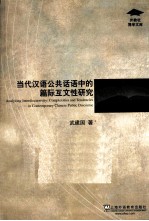

当代汉语公共话语中的篇际互文性研究PDF电子书下载
- 电子书积分:10 积分如何计算积分?
- 作 者:武建国著
- 出 版 社:上海:上海外语教育出版社
- 出版年份:2010
- ISBN:9787544620499
- 页数:207 页
Chapter One Introduction 1
1.1 Introduction 1
1.2 The object of the present study:interdiscursivity 4
1.3 The rationale of the present study 10
1.4 Objectives of the present study 12
1.5 Notes on methodology and data collection 13
1.6 Outline of the book 15
Chapter Two A Review of the Relevant Literature 17
2.1 Introduction 17
2.2 Terminological issue 17
2.3 Types of interdiscursivity 19
2.4 Interdiscursivity as a special kind of intertextuality 24
2.5 Approaches to the study of interdiscursivity 27
2.5.1 Interdiscursivity in literary texts:the stylistic approach 27
2.5.2 Interdiscursivity in non-literary texts:the CDA approach 31
2.6 The perspective of the present study 37
2.7 Summary 39
Chapter Three A Description of the Theoretical Framework 40
3.1 Introduction 40
3.2 The delimitation of interdiscursivity 40
3.2.1 A working definition of interdiscursivity 41
3.2.2 Interdiscursivity versus intertextuality 44
3.2.3 Interdiscursivity versus generic intertextuality 46
3.2.4 Interdiscursivity versus heteroglossia 46
3.2.5 Interdiscursivity versus dialogicality 47
3.3 Basis of the theoretical framework 48
3.3.1 Problems in the existing studies on interdiscursivity 49
3.3.2 Studying interdiscursivity from a pragmatic approach 50
3.3.2.1 Overview of pragmatics 50
3.3.2.2 Pragmatics as a functional perspective on language 51
3.3.2.3 Verschueren's Linguistic Adaptation Theory 54
3.4 Essentials of the theoretical framework 59
3.4.1 Interdiscursivity as the result of choice making 59
3.4.2 Interdiscursivity as the product of dynamic negotiation 61
3.4.3 Interdiscursivity as a means of linguistic adaptation 62
3.4.4 Interdiscursivity interpretation:tracing meaning generation 65
3.4.5 Interdiscursivity as realization of communicative functions 66
3.4.6 Variability of interdiscursivity 67
3.5 Summary 68
Chapter Four Mechanism of Interdiscursivity 72
4.1 Introduction 72
4.2 Defining the notion of mechanism 73
4.3 The productive mechanism of interdiscursivity 74
4.3.1 Recontextualization 77
4.3.2 Transformation 81
4.4 The interpretative mechanism of interdiscursivity 86
4.5 Summary 100
Chapter Five Adaptability of Interdiscursivity 101
5.1 Introduction 101
5.2 Adaptability and adaptation revisited 102
5.3 Objects of adaptation 104
5.4 Interdiscursivity as adaptation to variables of the physical world 107
5.4.1 Variables of the physical world 108
5.4.2 Analysis 109
5.5 Interdiscursivity as adaptation to variables of the social world 117
5.5.1 Variables of the social world 117
5.5.2 Analysis 119
5.6 Interdiscursivity as adaptation to variables of the mental world 123
5.6.1 Variables of the mental world 124
5.6.2 Analysis 125
5.7 Summary 132
Chapter Six Functionality of Interdiscursivity 134
6.1 Introduction 134
6.2 Defining the notion of functionality 135
6.3 Main trends of public discourse in relation to interdiscursivity 136
6.4 Functionality of interdiscursivity in relation to discourse commodification 139
6.5 Functionality of interdiscursivity in relation to discourse informalization 149
6.6 Functionality of interdiscursivity in relation to discourse technologization 156
6.7 Functionality of interdiscursivity in relation to discourse democratization 160
6.8 Summary 162
Chapter Seven Conclusion 164
7.1 Introduction 164
7.2 Major findings 165
7.3 Limitations of this study 169
7.4 Suggestions for future research 170
Bibliography 172
Appendices 182
Figure 3.1 Contextual Correlates of Adaptability 56
Figure 3.2 The Structure of a Pragmatic Theory 57
Figure 3.3 Interdiscursivity as a Means of Linguistic Adaptation 63
Figure 3.4 Interdiscursivity as Adaptation 64
Figure 3.5 The Theoretical Framework of the Present Study 69
Figure 4.1 Relations between Interdiscursive Elements in(5) 77
Figure 5.1 Objects of Adaptation 104
- 《红色旅游的社会效应研究》吴春焕著 2019
- 《汉语词汇知识与习得研究》邢红兵主编 2019
- 《生物质甘油共气化制氢基础研究》赵丽霞 2019
- 《东北民歌文化研究及艺术探析》(中国)杨清波 2019
- 《联吡啶基钌光敏染料的结构与性能的理论研究》李明霞 2019
- 《异质性条件下技术创新最优市场结构研究 以中国高技术产业为例》千慧雄 2019
- 《《国语》和《战国策》词汇比较研究》陈长书著 2017
- 《中国制造业绿色供应链发展研究报告》中国电子信息产业发展研究院 2019
- 《行政保留研究》门中敬著 2019
- 《新课标背景下英语教学理论与教学活动研究》应丽君 2018
- 《中风偏瘫 脑萎缩 痴呆 最新治疗原则与方法》孙作东著 2004
- 《水面舰艇编队作战运筹分析》谭安胜著 2009
- 《王蒙文集 新版 35 评点《红楼梦》 上》王蒙著 2020
- 《TED说话的力量 世界优秀演讲者的口才秘诀》(坦桑)阿卡什·P.卡里亚著 2019
- 《燕堂夜话》蒋忠和著 2019
- 《经久》静水边著 2019
- 《魔法销售台词》(美)埃尔默·惠勒著 2019
- 《微表情密码》(波)卡西亚·韦佐夫斯基,(波)帕特里克·韦佐夫斯基著 2019
- 《看书琐记与作文秘诀》鲁迅著 2019
- 《酒国》莫言著 2019
- 《培智学校义务教育实验教科书教师教学用书 生活适应 二年级 上》人民教育出版社,课程教材研究所,特殊教育课程教材研究中心编著 2019
- 《习近平总书记教育重要论述讲义》本书编写组 2020
- 《办好人民满意的教育 全国教育满意度调查报告》(中国)中国教育科学研究院 2019
- 《教育学考研应试宝典》徐影主编 2019
- 《语文教育教学实践探索》陈德收 2018
- 《家庭音乐素养教育》刘畅 2018
- 《学前教育学》王换成主编 2019
- 《近代体育游戏教育史料汇编 第1辑 1》王强主编 2016
- 《全国学前教育专业(新课程标准)“十三五”规划教材 简谱手风琴教程 第2版》(中国)杨克勤,王宝庆 2019
- 《现代教育技术》李志河主编 2019
